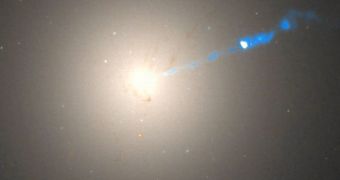For many years, astronomers have believed that elliptical galaxies formed through the collision of two or more, smaller spiral galaxies during a catastrophic event. Experts now propose an alternative mechanism that may have yielded the same result, and which does not require collisions.
Ellipticals are galaxies that can have a wide variety of shapes and size, but which do not feature spiral arms and central bulges at the core of a flattened disk, as their spiral counterparts do.
They can range in shape from ellipsoid to smooth or even cigar-shaped, and vary in size and mass greatly. Some of them may have as little as a few million stars, whereas the supermassive variety tends to feature in excess of one trillion stars.
For comparison, our own Milky Way, which has a diameter of 100,000 light-years and weighs 100 billion times the mass of the Sun, features between 200 and 400 billion stars.
Over the years, as more and more ellipticals were being discovered, experts determined that there is a higher chance of finding them at the core of galaxy clusters than anywhere else. It is believed that most of the largest such objects are powered by supermassive black holes living at their cores.
But experts at the Swinburne University of Technology in Australia disagree with this interpretation. They say that elliptical galaxy may start out as dense molecular cloud, which then collapses in on itself to produce a massive number of new stars.
This forms the core for the future galaxy, and it grows that accreting smaller clusters and tiny galaxies over billions of years. In time, they can grow to massive sizes, and accumulate countless stars.
Astronomer Duncan Forbes, the leader of the SUT research team, looked at the colors of star clusters in the elliptical galaxy NGC 1407, and used the data to estimate their chemical makeup.
One of the most interesting discoveries was learning that the highest concentration of stars rich in heavy chemical elements could be found at the core of the galaxy, a fact that s consistent with the new explanation, Daily Galaxy reports.
It was also found that heavy-element concentrations decreased progressively the further the experts went towards the exterior sectors of the galaxy. This further supports the gas cloud-collapse theory.
It's still a matter of debate today whether elliptical galaxies and the bulge structures of spiral galaxies share the same formation mechanism. This has been proposed some time ago, when experts noted that the two shared similar dynamical properties.
The new idea strengthens the arguments of those who support that idea that the two types of galaxies do not share such mechanisms in common.

 14 DAY TRIAL //
14 DAY TRIAL //